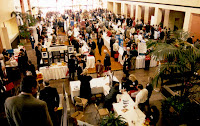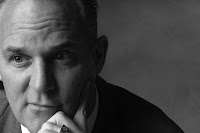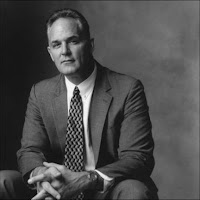For the first time ever one of my client firms is conducting face-to-face client satisfaction surveys with their top clients. The PIC (partner-in-charge) that I work with is ecstatic about how it's progressing. He was practically glowing as he talked about the process and the client meetings.
I recall at Deloitte how this process was an annual, mandatory activity that generated incredibly wonderful results every year!
At my client firm the idea of satisfaction surveys had been shot down in previous years. One partner was reported to have stated, "Our clients must be happy or they would tell us if they were not." I apologize for being blunt but that reasoning is just silly!
Demonstrating you care about someone else, before yourself, is the single most active thing you might do to deepen any relationship!
This post from Jim Hassett, directed at law firms, is a good starting point for getting your act together in this matter.
Do not ever forget -- in any relationship, professional or personal, the best thing you can accomplish as often as possible is to remind someone that they matter.
Thursday, September 25, 2008
Thursday, September 18, 2008
Being Productive at Business Conferences
 Attending business conferences is a great way to check out from the office, put deadline stress on hold and hang out at a luxury hotel, get in some golf, indulge at a spa, and attend some hosted receptions (i.e., party). But after it's over, what did you accomplish beside turn in an expense report?
Attending business conferences is a great way to check out from the office, put deadline stress on hold and hang out at a luxury hotel, get in some golf, indulge at a spa, and attend some hosted receptions (i.e., party). But after it's over, what did you accomplish beside turn in an expense report?Many of my clients ask if attending conferences is useful for growing their practice or marketing themselves -- my short answer is "yes". This advise from Matt Homann over at "the [non]billable hour" is pretty close to how I might answer the question. In particular I appreciated Matt's comments about whom to seek out at an event:
"The most important people at the conference are sitting next to you. Think Tom Peters gives a rat’s ass about your new business strategy? Is Seth Godin going to give you personalized marketing advice? Of course not. The people at any event who are most likely to have already faced your challenges (and maybe even solved them) aren’t the highly-paid keynoters, but rather your fellow attendees. They are like you. They can help you. Ignore them at your peril."Some of the most important people in my Rolodex are those I met at conferences around the country. They are high on my list of people to contact when I face client and marketing challenges -- and they have not been shy about reaching out to me. Often their call has resulted in new business for me, and every time it has been a growth experience.
I encourage you to read and heed Matt's advise.
Tuesday, September 16, 2008
What Not to Do with an Unhappy Client
There is plenty of advise offered on how to keep clients happy, but what do you do when the client is not? More importantly, what should you NOT do -- what actions might you be inclined to take that will make the situation worse? I don't know about you but this also sounds like coming home to an unhappy spouse? And since client relationships are much like dating and marriage, the similarity is quite real. Here are my thoughts on what not to do:
- Do not try to talk your client out of what they are feeling. No matter your perspective theirs is the only one that counts to them. To try and change their feelings is futile. Simply accept what they feel and verbally acknowledge that to them.
- Do not offer a solution without hearing what they have to say about the situation first. Without knowledge of what they think went wrong you are shooting in the dark with half-baked ideas and assumptions.
- Do not deny wrong-doing even if you can't see it yet or it is not true. Accept and acknowledge what they see as wrong.
- Do not point out their errors if there are any. This is definitely not a time for cross-blaming or stating resentments.
- Do not put up walls of ego. Ask humbly what it would take to make this better. Not everything they might offer will make sense but allowing them to be and feel in control will later turn into empathetic compromise.
- Do not make any assumptions about what actually happened. Take the time to understand what did go wrong at your end whether it was your actions or someone else in your firm, and what part the client may have played in all of this.
- Do not try to gloss over anything with weak words and broad statements. Your client is going to need to know specifically how you will fix their problem. It may require some amount of time on your part to actually come up with a plan, which you can ask for. Just make sure to stay in constant contact with the client while you are planning.
- Do not propose a plan of recovery that includes only your participation (unless that is only what is needed). In your plan of action be perfectly clear about what you will do and what they need to do to reach a their expectation. This is perfect time to address what they did not do that contributed to a poor situation -- but never suggest blame or poor performance.
Saturday, September 13, 2008
Memorable Experiences are the Best Spent Business Development Dollars
 The dugout suites at Angels Stadium in Anaheim, CA are the perfect place to create a memorable experience for a client or prospect, as was the case last night.
The dugout suites at Angels Stadium in Anaheim, CA are the perfect place to create a memorable experience for a client or prospect, as was the case last night. I was the guest of Tony Saucedo, a VP at First Republic Bank at the Angels vs. Mariners matchup. Sitting at ground level the Angel batters circle was five feet directly in front of us. We witnessed conversations between players, coaches and umpires. It was like we were inside the game, not just observing it. And the best part came in the bottom of the ninth inning when Mike Napoli (Angels catcher) broke up a tied game and hit a walk-off home run to win the game! Sweet!
I know I have talked about this in the past, but it is SO worth repeating. Your best marketing dollars are spent on creating memorable experiences! It is way to easy to just do the normal stuff like taking someone to lunch or meeting them for drinks after work -- but that is so average it is almost forgettable!
Think about the moments you've remembered days, months or even years after... and this is where you can start to form ideas about what you can do to create a real bond with a client or prospect.
I know for certain my relationship with First Republic Bank keeps getting deeper and more wonderful because they treat me like someone that matters. They keep offering me memorable experiences that I appreciate -- exactly the sort of things that will keep me loyal and a fan.
I encourage you to touch your network of important relationships in a similar way. Think of ways to create memorable moments and you will be creating ways to bring people closer to all that you desire.
Tuesday, September 09, 2008
Becoming the Most Popular Person at a Networking Event
I noticed a long time ago that some individuals at every event are always in the middle of the networking action. And, so many times it is the same individuals appearing at multiple events. How do they do that? What do they know about working a room that I need to learn?
It turns out their secret (which was not much of a secret at all) is they knew how to become a hub in the midst of people looking for connections and conversations. I've talked with many of them, dug around in their heads, and emerged with what has worked for them. Here is their simple advise:
It turns out their secret (which was not much of a secret at all) is they knew how to become a hub in the midst of people looking for connections and conversations. I've talked with many of them, dug around in their heads, and emerged with what has worked for them. Here is their simple advise:
- Arrive on time.
- As the bulk of the guests were arriving observe how they flow into the reception area to see where they linger and cluster.
- Identify a few people you know and watch where they went.
- Say hello to folks as they arrive but avoid getting onto extended conversations early so that you can continue to watch the opening interactions.
- Once you have a good feel for how the event will flow seek out people you know, begin a conversation, and start working yourself to the center of networking action.
- Start making introductions. Reach out as people go by and introduce them to whom you are talking to.
- Do it over, and over and over again.
- From time to time excuse yourself, grab somebody (politely) and walk them to another contact they would like to meet.
- Repeat
Friday, September 05, 2008
The Road to Success -- Avoiding Leadership Failure
Jerry Wilkinson (sales executive extraordinaire and former NFL standout) is my guest blogger today -- a tremendous honor for me. Jerry has been a leader for most of his professional career and I am certain what he's learned is worth hearing. . . .
The Road to Success -- Avoiding Leadership Failure
By Jerry Wilkinson
 To maximize effectiveness in a leadership role today, there are 5 distinct behaviors to avoid. Most of these pitfalls are covert traps that leave the best-intentioned leader in a “gap” or sorts, unable to sustain “touch” with the business and more important, its customers. Ignored, unnoticed or unchallenged for too long a period of time and it’s easy to see how business setbacks occur.
To maximize effectiveness in a leadership role today, there are 5 distinct behaviors to avoid. Most of these pitfalls are covert traps that leave the best-intentioned leader in a “gap” or sorts, unable to sustain “touch” with the business and more important, its customers. Ignored, unnoticed or unchallenged for too long a period of time and it’s easy to see how business setbacks occur.
In tough, economically jarring times like these, no business wants to suffer at the hands of their competitors due to unforced errors of basic leadership best practices that could altogether be avoided. Here are the Top 5:
 Jerry Wilkinson works with organizations interested in “next level” performance. For more than 20 years, his leadership style and business experience as Vice President of Sales, Marketing and Business Development for firms ranging in size from $4 million to more than $400 million in annual sales provide a platform for sales and market-share growth as well as people development.
Jerry Wilkinson works with organizations interested in “next level” performance. For more than 20 years, his leadership style and business experience as Vice President of Sales, Marketing and Business Development for firms ranging in size from $4 million to more than $400 million in annual sales provide a platform for sales and market-share growth as well as people development.
As a championship athlete and professional football player, Jerry has had the privilege of working alongside a cache of world-class coaches who have impacted and influence his energy, work ethic and dedication including Dee Andros, Craig Fertig, John McKay, Don James, Ralph Miller, Ray Malavasi, Sam Rutigliano, Bill Walsh, Tom Flores, and John Ralston not to mention business leaders and mentors from the healthcare, legal services, and consumer products industry who played a role in his development.
Jerry resides in Mission Viejo, California with his wife, Brenda.
The Road to Success -- Avoiding Leadership Failure
By Jerry Wilkinson
 To maximize effectiveness in a leadership role today, there are 5 distinct behaviors to avoid. Most of these pitfalls are covert traps that leave the best-intentioned leader in a “gap” or sorts, unable to sustain “touch” with the business and more important, its customers. Ignored, unnoticed or unchallenged for too long a period of time and it’s easy to see how business setbacks occur.
To maximize effectiveness in a leadership role today, there are 5 distinct behaviors to avoid. Most of these pitfalls are covert traps that leave the best-intentioned leader in a “gap” or sorts, unable to sustain “touch” with the business and more important, its customers. Ignored, unnoticed or unchallenged for too long a period of time and it’s easy to see how business setbacks occur.In tough, economically jarring times like these, no business wants to suffer at the hands of their competitors due to unforced errors of basic leadership best practices that could altogether be avoided. Here are the Top 5:
- Avoid playing desk jockey. It’s akin to riding the bench. No one can create impact if they’re not in the game. The anchor also known as a “desk” is intended for administrative support, customer service and billing personnel, never leaders. No one can effectively lead from behind a barrier.
When you think about it, doesn’t it sound oxy-moronic? “Effectively lead from behind…” Does your leader spend too much time sitting? Solution? Move! Walk right in to the field of play, run if you have to. Be intentional about seeing BOTH your internal and your external customers.
Movement is energy. Utilize your eyes your ears and your words of encouragement. Leave the saddle comfort of the desk for a run in the trenches. - Avoid the stoic demeanor. The less robotic you are the better. You’re not Mr. Spock from the USS Enterprise. You’re human and people want a relationship with their leader. They mostly want to be known by you. Don’t be afraid to engage with your troops to show them you do carry some human-like DNA.
Most people succeed in life when they feel “directed and connected.” When that doesn’t happen, there are signs of unrest and instability amongst the rank and file. “Nobody gets promoted around here” and “Why bother” tends to be the mantra of many outside of the leaders circle.
Unseen or unappreciated employees become more disillusioned than inspired and are generally flight risks joking or posturing to join the competition. Check to see if turnover becomes the norm rather than the exception. Customers like “steady.” Clients appreciate consistency with no surprises. Stable customers become great testimonials and references for new clients.
Robots don’t build relationships, humans do. Make the time to be somewhat engaging, and retain the employees that you know are solid ambassadors for the company. - Avoid following up, checking in and asking the tough questions. Don’t care? They don’t ask. Wasn’t really that important. Couldn’t have been that important. That’s what it seems like to those in a performance-oriented practice (what isn’t these days?) who actually expect the leader to inspect progress.
Leaders with great follow up tend to gain traction faster in everything that is measured. Those that don’t follow up lose ground quick and are at a loss for why. - Avoid making the employees feel like they work for you. Make it appear to others that you’re actually working to help them find and achieve success. The reality of it is, is that subordinates are not employed to equip and empower leaders. It’s the other way around.
Leaders exist to create organizational results. Leaders should be like high-powered consultants. They should be savvy and skilled enough to help expose and overcome challenges while yielding a positive result. Leaders exist to equip and empower others for both the short and long term. What a leader leaves in his or her wake are tell tale signs of their effectiveness.
Servant leaders tend to establish loyalty bonds that can never be broken. Quality leaders have a knack for preparing a foundation for succession planning as they are able to grow fresh understudies with ambitious designs.
Have you ever noticed the come-back factor in play? Athletes and students always return to the place(s) where they grew the most under the tutelage of a former teacher or coach. Why is that? - Avoid letting passion fade. People come to work as a means to build a life (style) for themselves they couldn’t otherwise do without a job. While there are differing levels of internal motivation to do a job well there are moments when a leader can inspire his or her team to brilliant contribution.
Outstanding leaders need to be in touch with an appropriate(ness) “clock”, meaning they need to know the right time(s) to challenge, to reward, to celebrate, to recognize, to appreciate and to have fun.
An engaged leader has the pulse of his team wired. He knows when to tick them up a notch and when to downshift. A great leader NEVER gets a day off in the passion category because people watch and feed off of the tempo the leader creates. If the leader is not the most inspired, enthusiastic and motivated person in the company it becomes extremely difficult pass this characteristic on within the culture.
Perseverance, the dogged determination that brings people back to the fight each and every day comes from a discipline born out of passion. The desire to become a little bit better (at something, anything) than the day before means to make every minute marching toward achievement counts.
- Movement. Spotted in the trenches, movement not only gathers respect, it helps leaders understand first hand what elements are in play both inside (and outside) the business. This has a profound affect on a leaders with decision making capability.
- Human DNA. Connectors of humans are more approachable. More approachable human beings display authenticity. This transparency often helps others become attached to something larger than themselves, and when this occurs, “team” emerges and a fan base is built.
- Evaluator-forensics. The ability to ask, dissect and help determine next step measures equips leaders to help problem solve by making subtle adjustments to new (or old) challenges. This is the half-time speech and plan!
- Servant leadership. One who equips, empowers and is able to help others strive to reach personal bests in contribution and performance is a rare find. When you see it, grab it. Make sure this individual is on your team and not the competition.
- Passion. Got pulse? Most of the best coaches in the world would agree on this one thing, “You cannot coach ‘heart.’ ” When you see it, you’ve got to capture it. Recruit it, draft it, trade for it. Humans are drawn to motivation, and motivation is a matter of the heart.
 Jerry Wilkinson works with organizations interested in “next level” performance. For more than 20 years, his leadership style and business experience as Vice President of Sales, Marketing and Business Development for firms ranging in size from $4 million to more than $400 million in annual sales provide a platform for sales and market-share growth as well as people development.
Jerry Wilkinson works with organizations interested in “next level” performance. For more than 20 years, his leadership style and business experience as Vice President of Sales, Marketing and Business Development for firms ranging in size from $4 million to more than $400 million in annual sales provide a platform for sales and market-share growth as well as people development. As a championship athlete and professional football player, Jerry has had the privilege of working alongside a cache of world-class coaches who have impacted and influence his energy, work ethic and dedication including Dee Andros, Craig Fertig, John McKay, Don James, Ralph Miller, Ray Malavasi, Sam Rutigliano, Bill Walsh, Tom Flores, and John Ralston not to mention business leaders and mentors from the healthcare, legal services, and consumer products industry who played a role in his development.
Jerry resides in Mission Viejo, California with his wife, Brenda.
Wednesday, September 03, 2008
Steps for Moving New Marketing Ideas Forward Successfully
Great marketing ideas and initiatives die by the dozens every day in law and accounting firms (and just about every other type of organization). How is it that good ideas can tank so quickly? The new client care program; the leadership program; the new website and branding.... So many wonderful ideas with "no future here".
No matter how fantastic my proposed marketing programs might have been there are some things I've always HAD to do to enable success. Otherwise, I did not start -- failure was certainly close behind.
No matter how fantastic my proposed marketing programs might have been there are some things I've always HAD to do to enable success. Otherwise, I did not start -- failure was certainly close behind.
- The biggest fan of my project has to be the leaders of the firm: Not every project needs attention from the highest echelon but if it is a big program with far reaching implications, my highest leadership has to be the loudest cheerleaders. Never launch a culture-changing program until I've secured the best cheerleaders.
- Keep the decision circle small and influential: Many projects fail because too many people were asked to be part of the decision cycle. It is imperative that I orchestrate any committee formation around my idea to include as few people as possible whom are as influential as possible. I have moved so many projects forward based alone on the influence of hand-picked partners.
- Speed is my friend: The more radical an idea the faster it needs to move along. Nothing cripples a project more than offering people time to think (too long). I would definitely never hoodwink anyone, but, more time to think is equal to more time to consider fear.
- Knowing the difference between programs parts that can be compromised and those that cannot: Having room to adjust is important, and knowing what would neutralize my program is imperative. Once a program is neutralized it is time to stop and move on.
- Have external advisers: I have been so ready to tank good projects making good progress just because of my own self-doubt. Having good professionals on the outside of my firm to look over my shoulder have saved me time and time again.
- I drink a little bit of my own Kool-Aid: Intelligent passion sells! Never be afraid to be your own biggest cheerleader, your own biggest believer, and your own biggest supporter. I am certainly ready to listen to reality, but in the face of an illogical argument, passion has often won over many a dissenter.
Subscribe to:
Comments (Atom)
Graphic Artists are Crazy
I might know. I am one. But, not like, "Wooo Hooooo, la la la la la, put me in a rubber room!!" Go online and look at any portfo...
-
I might know. I am one. But, not like, "Wooo Hooooo, la la la la la, put me in a rubber room!!" Go online and look at any portfo...
-
Your top marketing resource for growth is at your office every day – your employees! We produced a day and 1/2 company retreat for the com...
-
The power of watch lists was confirmed not more than a few hours after I posted my remarks on using plug-ins on web sites... A very well spo...